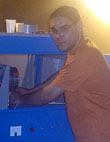|
|
This topic comprises 2 pages: 1 2
|
|
Author
|
Topic: Using metal halide bulbs for film projection
|
|
|
|
|
|
|
|
|
John Pytlak
Film God

Posts: 9987
From: Rochester, NY 14650-1922
Registered: Jan 2000
|
 posted 05-10-2002 12:44 PM
posted 05-10-2002 12:44 PM





To see how BAD mercury vapor or sodium vapor lamps are for "color rendering", just look at some critical colors (like a Macbeth Color Checker Chart) illuminated by streetlights. A red automobile looks almost gray under a mercury vapor lamp, which has very little light output in the red portion of the spectrum.An HMI lamp does have possibilities, but it will still need a ballast and won't cost much less than a comparable xenon lamp made for motion picture projection. For a small home screen, has anyone experimented with the new xenon lamps made for automobile headlights as a light source?
http://www.sylvania.com/xenarc/prodinfo.htm
http://www.legend.org/performance/mods/lighting-1.html
------------------
John P. Pytlak, Senior Technical Specialist
Worldwide Technical Services, Entertainment Imaging
Research Labs, Building 69, Room 7525A
Rochester, New York, 14650-1922 USA
Tel: +1 585 477 5325 Cell: +1 585 781 4036 Fax: +1 585 722 7243
e-mail: john.pytlak@kodak.com
Web site: http://www.kodak.com/go/motion
| IP: Logged
|
|
Brad Miller
Administrator

Posts: 17775
From: Plano, TX (36.2 miles NW of Rockwall)
Registered: May 99
|
 posted 05-10-2002 03:47 PM
posted 05-10-2002 03:47 PM




Matthew, this isn't a very elegant solution, but a cheap one that will work if you really do not want a xenon or carbon lamphouse.Go to flee markets and look for old 8mm home movie camera lights. There is one inparticular called the "Sun Gun" that you will normally see selling for $5 or less. It takes a 750 watt halogen lamp and has it's own little reflector built into it. The bulbs are cheap (less than $10) and it is an instant on/off and will produce an acceptable amount of light provided your screen isn't more than say 8 feet wide. Make sure you use a DBDT switch to control your motor and the light so you don't ever accidentally stop the projector motor and leave the lamp on. Also, make sure you have a fire douser in your projector. Like I said, it isn't the best solution out there, but from the sound of your project, it'll get you by.
| IP: Logged
|
|
|
|
|
|
|
|
|
|
Luciano Brigite
Master Film Handler

Posts: 277
From: Sao Paulo, SP, Brazil
Registered: Jan 2002
|
 posted 05-10-2002 11:20 PM
posted 05-10-2002 11:20 PM




I was thinking about asking for some advice here about using these bulbs instead of xenon or carbons but decided to ask around and found out that a few theatres here in Brazil,the ones I heard being in the same state I live, switched to HMI bulbs with the same wattage of xenons they were using and the results were very good. I believe it's not really a valid information since I heard it from the tech who made the changes.
I saw some of these bubls in action and think the color temp is about the same as xenon or daylight and i'm thinking about using these bulbs in my lamphouses too since I can't get carbons for a decent price.
I checked some informations about the HMI in the UShio's catalog ( theu call this kind of bulb UMI, Osram calls it HMI)
and came out with the following: ( the values bellow are from
575, 1200 and 2500 Watts bulbs, respectively)color temp= 5600K ( to all bulbs) Arc gap= 7mm , 10mm (1200/GS) 7mm (1200/HB), 14mm ( they have two bulbs in the 1200 W range) Luminous Flux= 49000lm , 110000lm , 240000lm Average life 750Hs ( 575 and 1200 W) 500Hs (2500W) The Osram's catalog gives some different information about the same bulbs, I don't have it in hand atm but the color temp was about 6000K for 575 and 1200W and 6300K for 2500W. Don't remember the arc gaps for the Osram bulbs, sorry. Hope this helps ...
| IP: Logged
|
|
Stefan Scholz
Expert Film Handler
Posts: 223
From: Schoenberg, Germany
Registered: Sep 1999
|
 posted 05-11-2002 06:08 AM
posted 05-11-2002 06:08 AM





Metal halides actually give a good color rendition, if used for stage lighting during photography or filming.
For motion picture purposes, you do require a point source of white color. Even with "color correct" metal halides, the different parts of the spectrum do not originate from a single point, different gases and rare earth components exhibit different spectral lines at different points of the arc.
Osram introduced a special 400 W HMI metalarc lamp for narrow gage film projection, about 10 years ago. Arc was the only suitable way to get brighter images, as the filament of a standard bulb reaches the size of the picture gate @ 250 Watts (16mm) and 100 Watts (8mm), therefore any increase in lamp size would not relate to higher light output.
HMI seemed an ideal source, 400 Hz square wave AC supply to be quite small and lightweight, as well as assuring long enough bulb lifespan, superior color rendition and arc stability as well as life compared to Marc 300 DC lamps.
Major problem was the uneven spectrum within the arc. The designer group ended up creating a lamp within a special ellyptical mirror consisting of at least 3 different focal planes, each for every color part of the spectrum. The technology of the mirror was anything but simple, and the light output extremely high. The lamp/ supply unit proved quite well in Bauer P8 machines. Still, the red end of the spectrum wasn't as good as with Xenons, lacking deep red content. The same bulbs and supply units are now standard in outdoor lighting and shop display window lighting applications, and sell, despite their complicated process, pretty reasonable due to quantities. In this type of application, the large reflector, and non existing focusing to a single point does give a stunning color rendition of >99% white daylight, with very low energy consumption.
In 1994 I was experimenting with the 16mm type 400W lamp, and integrated that into my Microcine 35 portable. The light output was comparable to a 1600 watt Xenon, but due to the lacking correct focusing of the optimized for 16mm mirror, the light color was not really nice, faces had an orange green touch, for instance. Still, for the purpose of making outdoor screening in a garden and town square it proved to work quite well.
And the nice fact at that time was: single phase 8lbs supply, no heavy rectifier.
Today I would only go for Xenon, better light, and rectifiers are lightweight, too. The most recent example I found was 20 lbs, 1o kW cont. out of a 40 Amp/ 230V singlephase circuit.
| IP: Logged
|
|
|
|
|
|
|
|
|
|
All times are Central (GMT -6:00)
|
This topic comprises 2 pages: 1 2
|
Powered by Infopop Corporation
UBB.classicTM
6.3.1.2
The Film-Tech Forums are designed for various members related to the cinema industry to express their opinions, viewpoints and testimonials on various products, services and events based upon speculation, personal knowledge and factual information through use, therefore all views represented here allow no liability upon the publishers of this web site and the owners of said views assume no liability for any ill will resulting from these postings. The posts made here are for educational as well as entertainment purposes and as such anyone viewing this portion of the website must accept these views as statements of the author of that opinion
and agrees to release the authors from any and all liability.
|

 Home
Home
 Products
Products
 Store
Store
 Forum
Forum
 Warehouse
Warehouse
 Contact Us
Contact Us




 Printer-friendly view of this topic
Printer-friendly view of this topic




















